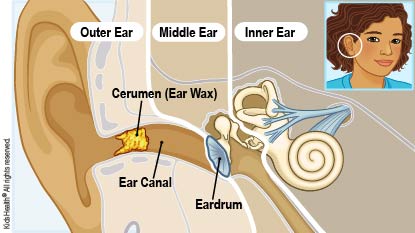Dealing With Earwax (Cerumen)
Why Do Ears Make Wax?
Earwax is made in the outer ear canal, the area between the fleshy part of the ear on the outside of the head and the middle ear. The medical term for earwax is cerumen (seh-ROO-mun).
Earwax has some important jobs. It:
- acts as a waterproof lining of the ear canal, protecting it and the eardrum from germs that can cause infection
- traps dirt, dust, and other particles, keeping them from injuring or irritating the eardrum
The wax makes its way through the outer ear canal to the opening of the ear. Then it either falls out or comes out during bathing. In most people, the outer ear canal makes earwax all the time, so the canal always has enough wax in it.

Does Earwax Need to Be Removed?
Usually, there's no need to remove earwax because it comes out by itself. Sticking anything into a child's ears raises the risk of infection or damage to the ear canal or eardrum. Cotton swabs are handy for a variety of grooming needs, but should not be used to remove earwax. In most cases, regular bathing is enough to keep it at healthy levels.
While some people have more earwax than others, in general the ear makes as much wax as it needs. Rarely, kids' ears do make too much earwax. And sometimes earwax can build up and block the ear canal, especially when pushed in by a finger, cotton swab, or other object. This is called "impaction." If it affects hearing or causes pain or discomfort, a doctor can remove it.
Parents — and kids — shouldn't attempt to remove earwax at home, even with remedies that promise to be safe and effective. Doing so risks damage to the ear canal and, possibly, a child's hearing.
What Can Parents Do?
If your child complains of ear discomfort and you see earwax in the ear, it's OK to wipe the outside of the ear with a washcloth. But don't use a cotton swab, a finger, or anything else to poke inside the ear. It could damage the delicate ear canal and eardrum, or pack the wax in even further.
Check with your doctor before using an over-the-counter earwax removal treatment.
When Should I Call the Doctor?
Call the doctor if your child has:
- ear pain, itchiness, or discomfort (like a blocked feeling in the ears)
- hearing problems
In infants and toddlers, tugging at the ears can be sign of an ear problem.
Sometimes doctors will remove earwax:
- if it's painful, itchy, or uncomfortable
- if affects hearing
- to get a better view of the eardrum to check for problems
Earwax removal usually is done in the doctor's office. There might be a little discomfort but it isn't painful. If a child can't sit still or cooperate, the doctor can remove it in an operating room while the child is under general anesthesia.
Doctors can remove earwax in different ways, including:
- scooping it out, pulling it out, or suctioning it out with special instruments designed for this purpose
- flushing it out with warm water. Sometimes a doctor will put drops into the ear canal to soften the wax and break it down. Or they might ask you to do this at home and then return to the doctor for wax removal.
Removal takes only a few minutes. If there's a sign of infection, the doctor may prescribe antibiotic ear drops.
What Else Should I Know?
Ear candling has gained a lot of attention as a home remedy for earwax removal. But it hasn't been proved to be safe or effective, and can be dangerous.
In ear candling, one end of a cone-type device is inserted into the ear canal and the other end is set on fire. The idea is that the fire and the cone form a vacuum and extract the wax. But trying this at home carries a high risk of:
- burning the ear canal
- punching a hole in the eardrum, which can cause permanent hearing damage
Whenever you have any concerns about your child's ears or hearing, call your doctor.


